soziale stadt - bundestransferstelle
besonderem Entwicklungsbedarf - Soziale Stadt"
Ludwigshafen Westend
|
Delia Schröder |
|||||||
1. Nature of the area 
In Rhineland-Palatinate, the model area selected for the "Socially Integrative City" programme is the Ludwigshafen neighbourhood of Westend. This 30 hectare area in the inner city is home to some 4,000 people. Westend has a multicultural population with a growing proportion of young migrants. Four out of ten residents are of non-German origin; in schools the proportion is even higher. Although the group of under-18s is only slightly larger in comparison to the city as a whole, the trend for some years now has been towards "rejuvenation" of the area - especially among non-Germans. More and more children and adolescents live in Westend. Also very strongly represented are population groups whose lives are subject to socio-economic constraints, like social-assistance recipients, single parents, and the unemployed. Typical is also the high fluctuation rate among the local population.
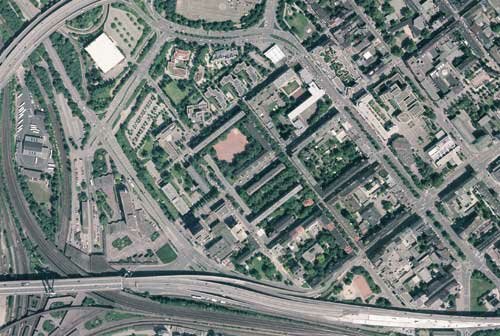 |
| (Source: Ludwigshafen Municipality, surveyors dept.) |
Characteristic of Westend is the extremely dense, mostly five-storey clinker-brick perimeter block development dating from the 1930s with additions from the 1950s. This so-called "Westend estate" with its gridiron layout is regarded as a classical working class area and is the nucleus of the present neighbourhood. Perimeter block development was abandoned in the north of the area in the 1970s. New construction since 1980 has produced about 40% of all existing dwellings - primarily in the southern part of the neighbourhood, where residential blocks and student hostels with up to twelve storeys were built.
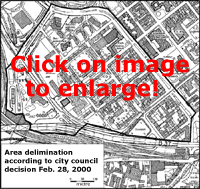 |
(Source: Ludwigshafen Municipality, surveyors dept.) |
Westend is encircled by major thoroughfares that have a considerable barrier impact, dividing the area off from the adjoining centre of Ludwigshafen and other neighbouring districts. The main railway station and railway yards form additional "fences."
Most buildings in Westend are exclusively residential. Some 830 of the 2,460 dwellings are owned by the municipal housing company "GAG Aktiengesellschaft für Wohnungs- Gewerbe- und Städtebau," and are for the most part social-welfare housing. On the fringes of the neighbourhood one finds a mixture of residential and small-scale commercial and industrial uses, the purely commercial or industrial use of a building tending to be the exception. Smaller food stores and service enterprises play an important role in serving the local population.
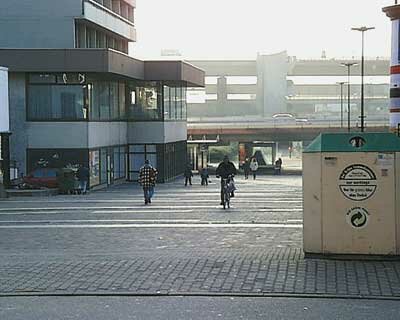 |
Oversized station forecourt and elevated highway in the background: who can identify with this locality? (Source: Ludwigshafen Municipality) |
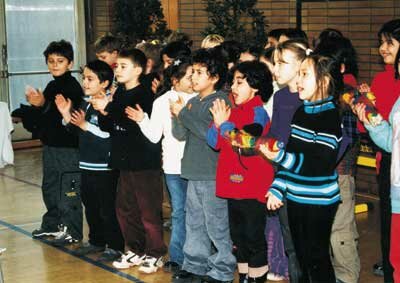 |
Children in Westend: they are the future (Source: Ludwigshafen Municipality) |
The social infrastructure is adequate, with three day-nurseries, a day-centre for school children, a primary school, an old-age home, and several municipal institutions. To the disadvantage of local children, however, two of the four playgrounds are in bad condition and poorly located.
2. Problems and Development Potential 
The most tangible problems are in the fields of urban planning and the environment. In Westend, the residential environment suffers from design shortcomings, open spaces are inadequate, and public spaces are dirty and untidy. Particularly badly affected are the square in front of the station and adjacent areas, which, owing to obsolete city-wide development notions from the 1970s are oversized and haphazard. Moreover, as was repeatedly mentioned at the residents' meetings on the "Socially Integrative City," many residents feel insecure because of the lack of visibility and dark "corners" in Westend, particularly at night.
But despite its faults, Westend has a certain charm. The red clinker-brick buildings, quite untypical for the region, roadside planting, and courtyards formed by the enclosed block development create a pleasant atmosphere and an overall streetscape with potential for development. What is more, the neighbourhood is favourably located between the centre of the city and the main railway station, and is well served by public transport.
The quality of life is negatively affected, however, by the often outdated layout and equipment of flats. A great deal of rehabilitation and modernisation is required to remedy deficiencies such as undersized and low-standard dwellings or the lack of outdoor spaces. To some extent, public facilities like the primary school are also in need of modernisation.
Demography and Social Space
|
Westend |
Ludwigshafen |
|
|
Size |
30.5 ha |
7 700 ha |
|
Population (2000) |
3 969 |
165 636 |
|
Population decline (1995–2000) |
5.6 % |
3.3 % |
|
Average household size (1999) |
1.6 pers. |
2.0 pers. |
|
Number of dwellings (2000) |
2 460 |
82 210 |
|
Vacant dwelling units |
n.a. |
n.a. |
|
Housing benefit recipients (2000) |
3.5 % |
n.a. |
|
Unemployment rate (1999) |
23.4 % |
11.7 % |
|
Social assistance recipients (2000) |
9.5 % |
4.2 % |
|
Foreign population (2000) |
40 % |
19.9 % |
|
Population under 18 (2000) |
18.8 % |
17.8 % |
|
Population 60 and older (2000) |
18 % |
24 % |
Interpersonal problems are primarily attributable to the socio-economic difficulties of residents. These difficulties find expression in an unemployment rate of 24%, almost twice as high as in the city as a whole, a very high proportion of social-assistance recipients, and many single parents with the double burden to bear of family and employment. Over and above this, differences in the everyday culture of the various nationalities cause tensions between neighbours. Finally, the relatively high fluctuation rate in the resident population makes it difficult for a stable community to develop. Integration is all the more difficult for people moving into the area because there is a lack of public life in Westend. There are no clubs, citizens' groups, or traditional forms of socializing in public spaces.
Nevertheless, a simple walk through the neighbourhood reveals where there is potential for sustainable development and what the future of the area is to be built on: the many children who live together here and who come together in the school playground or in the day nurseries. In the activities that have so far been undertaken in the context of the "Socially Integrative City" programme, they have also been the most enthusiastic and best motivated actors.
3. Development Goals and Focal Points of Action 
With regard to the most important problem areas and development potential in Westend, four general development goals were identified in a first plan of action submitted to the city council:
- Given the concentration of socially and economically disadvantaged population groups in the neighbourhood with the concomitant problems for community life, the "stabilisation of residents and their social and economic integration" is to be sought.
- Another superordinate goal is to "preserve the neighbourhood from further social decline and to ensure its improvement." Mutually determining and reinforcing negative developments in unemployment, poverty, poor living conditions, crime, etc., not only determine the quality of life for residents but also the image of the neighbourhood. The "Socially Integrative City" programme seeks to put a stop to self-reinforcing negative processes and to bring the neighbourhood up to the city average.
- The "integration of the neighbourhood in the district and the overall structure of the city" is important to prevent the neighbourhood from becoming an excluded and excluding social space. To prevent ghettoization, consistent spatial and development integration in the district and city as a whole city is required.
- To develop "an area with a future provided with adequate structural, infrastructural, and social quality" requires a considerable improvement in general living conditions in Ludwigshafen-Westend. Inadequacies in housing and in local infrastructure are to be tackled. Better framework conditions are wanted for a lively and sociable community life, and it is ultimately hoped to trigger economic regeneration through so-called soft locational factors.
The general goals have been specified during development of an urban framework plan. The following objectives were formulated on the basis of the urban planning analysis:
- Building structure: integration of peripheral areas of the neighbourhood in the urban space, conservation of structures in the core area and the creation of a neighbourhood "centre."
- Uses: basic maintenance of the use structure while improving the housing supply and locational preconditions for local industry and business.
- Transport: exploiting the potential of the "short-distance town" by improving traffic conditions, especially for pedestrians, cyclists, and public transport.
- Green/open spaces: qualitative upgrading of existing green and open spaces and making them available for public sojourn or play.
With the specification of urban planning objectives for the Westend neighbourhood, description of the 14 relevant areas of action, and a series of project proposals, the first update of the integrated plan of action has been developed.
4. Key Projects 
Among the first activities undertaken in the context of the "Socially Integrative City" programme in Westend were resident meetings and the setting-up of the Citizens' Bureau. This pointed the way for participatory and resident-supported implementation of the programme. For the actors responsible, hearing the opinions of local citizens is particularly important if planning is not to run counter to local views. In addition to a large number of small individual activities over the entire year, there have been some projects with particularly far-reaching consequences, given the special situation in Westend, and which can be hoped to have a sustainable impact.
|
Areas of action (AA) |
Selected Proposals for Measures and Projects |
|
AA Social structure |
- Provision of barrier-free dwellings |
|
|
- Provision of owner-occupied flats |
|
|
- Socially acceptable modernisation |
|
AA Building and use structure |
- Supplementation of development |
|
|
- Development of existing housing stock |
|
AA Social infrastructure |
- Remodelling of school grounds |
|
|
- Relocation of school sports facilities |
|
|
- Landscaping of open spaces (Westendhaus grounds, psychological counselling service, day-care nursery) |
|
|
- Premises for senior citizens' centre |
|
AA Culture |
- Link-up with the cultural amenities of the city centre |
|
|
- Installation of works of art |
|
AA Street spaces |
- Conception for street space design |
|
AA Public parking |
- Increase in the number of private parking spaces |
|
|
- Review of parking facilities |
|
AA Public transport |
- Tram-friendly extension of the stop Bgm.-Kutterer-Straße |
|
|
- Upgrading of the tram stop Hauptbahnhof |
|
|
- Relocation of the regional bus terminus |
|
AA Cycle traffic |
- Improved parking facilities for cyclists |
|
AA Pedestrian traffic |
- Improved pedestrian links |
|
AA Public open spaces |
- Renewal of playgrounds and integration in the environs |
|
AA Private open spaces |
- Courtyard planting |
|
|
- Toddlers' playgrounds |
|
AA Environmental protection |
- Aesthetic integration of recycling containers |
|
|
- Reorganisation of GAG refuse disposal |
|
|
- Examination of suspected contaminated land and brownfield sites |
|
AA Real property |
- Reorganisation of real property relations between GAG/municipality |
|
AA Building and planning law |
- Building and planning law protection for projects/ drawing up of a land-use plan |
|
|
Source: isoplan |
For example, there was the project to remodel the school playground of Erich Kästner Primary School. This measure, which turned the school grounds into an attractive play area and considerably upgraded play area quality in Westend as a whole, was preceded in 2000 by a children's conference with 400 young participants. Together with the children, the organisers staged workshops on various topics relevant for the district, like gymnastics, games and dancing for senior citizens and children, excursions with children through the Westend neighbourhood, and a painting and drawing campaign on neighbourhood design. However, the main focus was the workshop on school playground design, the results of which - like those of the other workshops - were presented at the plenary conference in the gymnasium. The children discussed their proposals with representatives of the municipality. Now one outcome of the conference can be inspected: the new school playground, which was opened in December 2001.
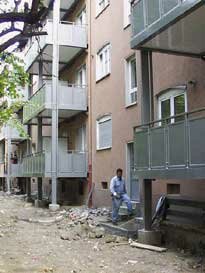 |
Balcony programme: fresh air at last - a marked improvement in the quality of life (Source: Ludwigshafen Municipality) |
Also visible are the results of first modernisation measures in buildings belonging to the housing company GAG, which have considerably improved the housing standards and contributed to upgrading the area. Besides the rehabilitation and merging of flats, the "balcony programme" has proved very popular among residents. The construction of modern balconies in steel or aluminium on GAG buildings aims to achieve a rapid and tangible improvement in dwelling quality. Another positive aspect is that the GAG supports the principle of participation, and had involved residents in information and coordination processes in connection with the choice of balconies and facades.
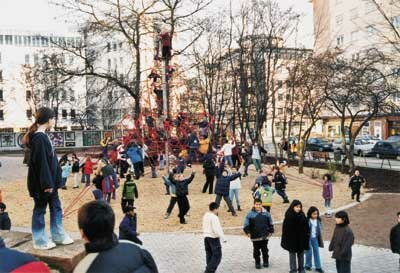 |
New design for school playground: fun in the break (Source: Ludwigshafen Municipality) |
A very important accent was also set with the 2001 street festival in Westend. For the first time in the memory of "Westenders" there was lively activity in the streets in which many residents, business people, and many institutions took an active part. There were numerous activities for children, and a number of amateur folklore groups presented a multicultural programme on the stage. The festival was so important because it brought together many actors in the planning and organisation phases and many residents for the festival itself, countering the rather disinterested normal state of affairs in Westend - a project that is to be repeated in this form in the years to come.
"Socially Integrative City" programme actors reacted to the severe unemployment problems with local employment and qualification measures. There is a contact point, "JOB XXL," which is responsible for the voluntary social training year for young people from and in the neighbourhood, and a scheme for the long-term unemployed. The objective is not only to integrate or reintegrate people into the labour market and enhance their employability but also to establish ties with the neighbourhood. Whenever projects and activities in Westend offer a useful opportunity, participants are brought into play. Residents know them already, for example, as "friendly helpers."
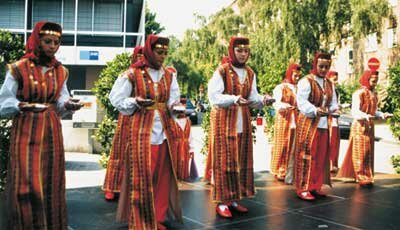 |
Street festival: folklore on the doorstep (Source: Ludwigshafen Municipality) |
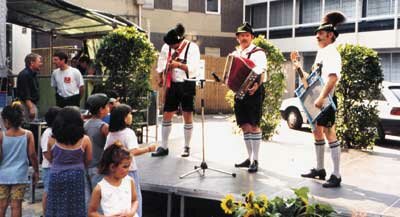 |
The planned redesign of Bahnhofstraße, the communication axis between the main station and the city centre, will involve planting, creating places where people can linger and meet, and visual upgrading.
5. Organisation and Management 
A coordinative, inter-authority approach to implementing the "Socially Integrative City" programme is ensured by coupling various administrative functions with external partners in an overarching project structure. To boost citizen engagement, the resident meetings and project-related planning and information discussions are to be developed into (issue-specific) neighbourhood forums.
The neighbourhood forum is understood as a working group bringing together not only project management, neighbourhood management, and district director but also other institutions and actors from the area. Interested citizens can join the forum at the residents' meetings. The neighbourhood forum should meet several times a year to discuss possible and planned measures in the neighbourhood, and help organise and stage events.
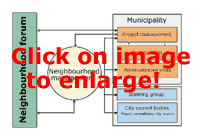 |
Neighbourhood forum |
Once the neighbourhood forum has developed and elaborated project proposals, they are to be submitted to the steering group composed of representatives of the parties on the city council and the district directors. The steering group discusses the projects and forward proposals along with its recommendation to the competent municipal bodies jointly responsible with the neighbourhood management for preparing and implementing projects.
The administrative units in the municipality responsible for implementation of the "Socially Integrative City" programme are the following:
- project management is assigned to the "Staff unit for inter-departmental planning"; it is responsible for applications and for managing the programme, has a coordinating role in the implementation of measures, and collaborates closely with the neighbourhood management;
- the control team, an interdisciplinary communication body that discusses fundamental problems and circumstances as well as development objectives for the "Socially Integrative City" area, and prepares internal administrative procedures;
- the various specialised administrative units in the municipality that are involved in the process from the initiation to implementation of measures; they are to take part in the neighbourhood forum participatory process - up to the autonomous realisation of the projects.
The city council has the last say on whether projects are actually to be realised, i.e., the standing committees recommend implementation of specific measures. Once a year the general purposes committee adopts a catalogue of measures for the current programme year. Any changes desired are forwarded to the competent functional units for modification and resubmission.
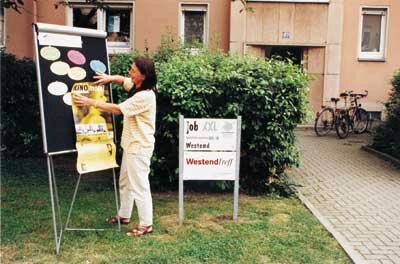 |
Westend Centre Citizens' Bureau: All are welcome (Source: Ludwigshafen Municipality) |
The neighbourhood management, the interface between programme management and local residents, has important functions in the area, such as maintaining a local presence, initiating and coordinating public participation, and preparing and carrying out projects. Other areas of responsibility are neighbourhood-related public relations and the organisation and moderation of meetings and the neighbourhood forum. The neighbourhood manager also participates in internal municipal bodies.
6. Activation, Participation and Public Relations 
In the integrated plan of action for the programme area Ludwigshafen-Westend, public participation and cooperation between all relevant local actors are entrenched as central principles for the planning and implementation phases. More fundamental and long-term changes are possible only "if the citizens approve and are willing to commit themselves. But this also means that they have to be fully informed and involved in the processes. Similarly, all local societal forces like welfare institutions, the churches, housing companies, etc., are to be included and their resources used," to quote the plan.
To this end, a range of activation and participation forms as well as effective publicity measures are available to actors in implementing the programme.
Activation techniques are used primarily by the neighbourhood manager, who endeavours in informal discussion with residents, business people, and other actors to win "comrades-at-arms" for the "Socially Integrative City" programme in Westend. A very important role is played by so-called multipliers, the staff of day-care nurseries and schools, of youth and women's clubs, clergymen, etc. Constant contact and cooperation with these actors makes it possible to learn more about the wishes and needs of the local residents, and, vice versa, to communicate the ideas of the "Socially Integrative City" programme to them. Sporadically, neighbourhood inspections have also been used as an activation technique, for example on the topic of "security."
District conferences and working parties have proved their worth as participation forms. They are used whenever a project is to be developed on a particular topic. The working groups that have been set up, for example to get the street festival or art projects under way, have assumed responsibility for preparations and organisation. In the past, this method has worked very well. What has not worked, owing to a lack of interest, has been a prospects or planning workshop with young people for the purpose of designing opening spaces in the neighbourhood. Among the directly participation-oriented activities to be mentioned are the children's conference and the campaign "Clean Westend."
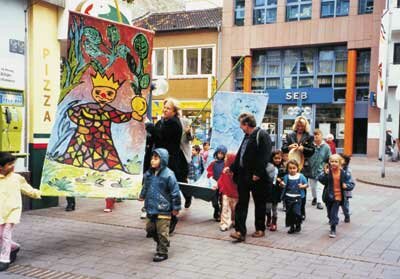 |
Flag project: Children paint their world (Source: Ludwigshafen Municipality) |
Public relations for the "Socially Integrative City" programme is among the central tasks of the neighbourhood management. It plays an important role in ensuring the transparency of planning and implementation and in public activation. The key factor is the newspaper "Im Westend zu Haus" ("At Home in Westend"). Since August 2000 is has been brought out every two months in an edition of 3,000 by the Ludwigshafen municipality, and is distributed to all households in Westend. Residents can find information and can themselves report on the current status of programme implementation, individual activities and events, and about the history of their neighbourhood. In addition to this permanent measure for informing Westend residents, less comprehensive, one-off, but nonetheless very effective campaigns and activities take place. The "Art Path," for example, comprises several individual projects over the entire term of the "Socially Integrative City" programme aimed at enlivening and embellishing public street space. The "Flag Project" had Westend children paint lengths of material under the guidance of an artist and carry their flags in procession to the city hall on the UNICEF action day 7th September 2001. Afterwards the colourful banners flew in front of the Westend offices of the municipal advisory service for children, young people, and parents, with a brief winter interlude.
7. |
Conclusion: Opening Up the District, Developing Structures - Westend's Becoming a Good Place to Live
|
Westend is a neighbourhood with a very special character of its own - it will be interesting to see how it develops in future. The potential for development lies in the form of the neighbourhood and vital population mix. With an eye on the future existing difficulties are easier to overcome. The "Socially Integrative City" programme has already pointed the way in important direction. Improving the dwelling situation through modernisation measures "gets to" the population, addressing their immediate needs. Furthermore, all the projects undertaken have helped people in the area to "experience" their neighbourhood. Finally people have the feeling they have "got something going." The actors involved in the "Socially Integrative City" programme see their engagement largely justified by the positive response to the projects that have been carried out to date. In future, additional issues will be addressed, like "crime prevention" and "local economy." As far as management and organisation of the programme are concerned, the current structure has already been adapted in reaction to a new situation, namely that three further areas in Ludwigshafen have been designated "Socially Integrative City" programme areas. In future it will therefore be necessary to ensure the meaningfully coordination of projects, measures, and activities in a citywide context, and to learn from one another.
Im Auftrag des BMVBS vertreten durch das BBR. Zuletzt geändert am 25.05.2005